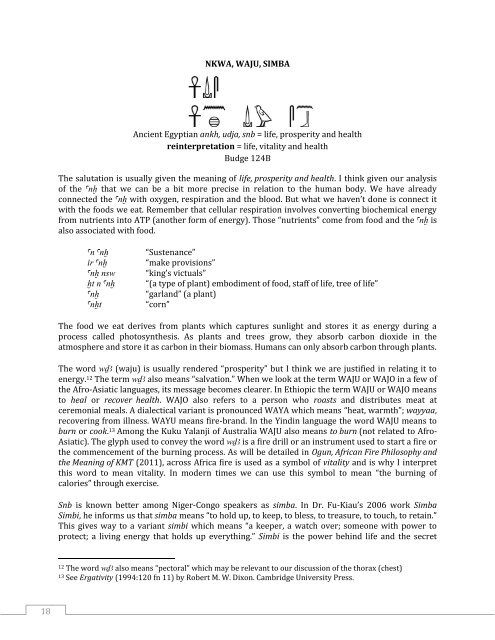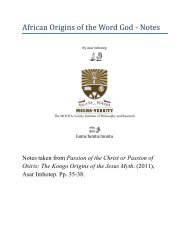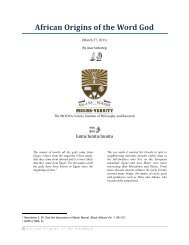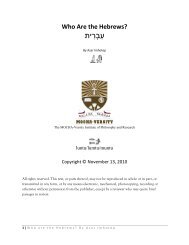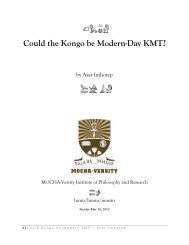reinterpretations of the ankh symbol part 2 - Asar Imhotep
reinterpretations of the ankh symbol part 2 - Asar Imhotep
reinterpretations of the ankh symbol part 2 - Asar Imhotep
You also want an ePaper? Increase the reach of your titles
YUMPU automatically turns print PDFs into web optimized ePapers that Google loves.
18<br />
NKWA, WAJU, SIMBA<br />
Ancient Egyptian <strong>ankh</strong>, udja, snb = life, prosperity and health<br />
reinterpretation = life, vitality and health<br />
Budge 124B<br />
The salutation is usually given <strong>the</strong> meaning <strong>of</strong> life, prosperity and health. I think given our analysis<br />
<strong>of</strong> <strong>the</strong> anx that we can be a bit more precise in relation to <strong>the</strong> human body. We have already<br />
connected <strong>the</strong> anx with oxygen, respiration and <strong>the</strong> blood. But what we haven’t done is connect it<br />
with <strong>the</strong> foods we eat. Remember that cellular respiration involves converting biochemical energy<br />
from nutrients into ATP (ano<strong>the</strong>r form <strong>of</strong> energy). Those “nutrients” come from food and <strong>the</strong> anx is<br />
also associated with food.<br />
an anx “Sustenance”<br />
ir anx “make provisions”<br />
anx nsw “king’s victuals”<br />
xt n anx “(a type <strong>of</strong> plant) embodiment <strong>of</strong> food, staff <strong>of</strong> life, tree <strong>of</strong> life”<br />
anx “garland” (a plant)<br />
anxt “corn”<br />
The food we eat derives from plants which captures sunlight and stores it as energy during a<br />
process called photosyn<strong>the</strong>sis. As plants and trees grow, <strong>the</strong>y absorb carbon dioxide in <strong>the</strong><br />
atmosphere and store it as carbon in <strong>the</strong>ir biomass. Humans can only absorb carbon through plants.<br />
The word wDA (waju) is usually rendered “prosperity” but I think we are justified in relating it to<br />
energy. 12 The term wDA also means “salvation.” When we look at <strong>the</strong> term WAJU or WAJO in a few <strong>of</strong><br />
<strong>the</strong> Afro-Asiatic languages, its message becomes clearer. In Ethiopic <strong>the</strong> term WAJU or WAJO means<br />
to heal or recover health. WAJO also refers to a person who roasts and distributes meat at<br />
ceremonial meals. A dialectical variant is pronounced WAYA which means “heat, warmth”; wayyaa,<br />
recovering from illness. WAYU means fire-brand. In <strong>the</strong> Yindin language <strong>the</strong> word WAJU means to<br />
burn or cook. 13 Among <strong>the</strong> Kuku Yalanji <strong>of</strong> Australia WAJU also means to burn (not related to Afro-<br />
Asiatic). The glyph used to convey <strong>the</strong> word wDA is a fire drill or an instrument used to start a fire or<br />
<strong>the</strong> commencement <strong>of</strong> <strong>the</strong> burning process. As will be detailed in Ogun, African Fire Philosophy and<br />
<strong>the</strong> Meaning <strong>of</strong> KMT (2011), across Africa fire is used as a <strong>symbol</strong> <strong>of</strong> vitality and is why I interpret<br />
this word to mean vitality. In modern times we can use this <strong>symbol</strong> to mean “<strong>the</strong> burning <strong>of</strong><br />
calories” through exercise.<br />
Snb is known better among Niger-Congo speakers as simba. In Dr. Fu-Kiau’s 2006 work Simba<br />
Simbi, he informs us that simba means “to hold up, to keep, to bless, to treasure, to touch, to retain.”<br />
This gives way to a variant simbi which means “a keeper, a watch over; someone with power to<br />
protect; a living energy that holds up everything.” Simbi is <strong>the</strong> power behind life and <strong>the</strong> secret<br />
12 The word wDA also means “pectoral” which may be relevant to our discussion <strong>of</strong> <strong>the</strong> thorax (chest)<br />
13 See Ergativity (1994:120 fn 11) by Robert M. W. Dixon. Cambridge University Press.


